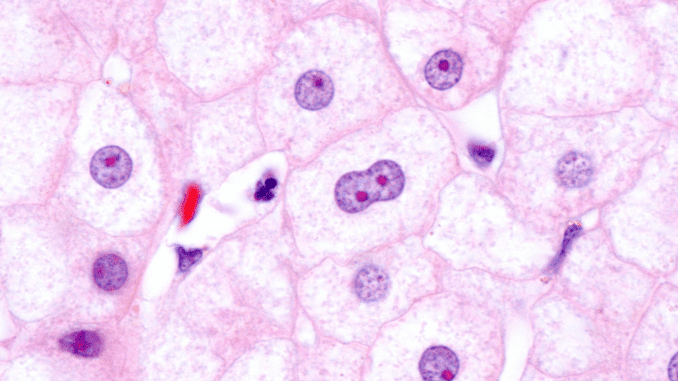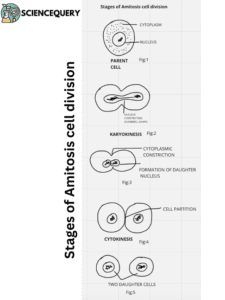
Introduction
Cells can reproduce from new cells. Continuity of life depends on cell division. In unicellular organisms, cell division is the means of reproduction. Multicellular organisms develop from a single-cell zygote which undergoes repeated cell division to differentiate into a new individual. There are three different processes of cell division namely amitosis, mitosis, and meiosis.
1. Amitosis (occurring in specialized cells)
2. Mitosis (occurring in somatic /body cells)
3. Meiosis (occurring in reproductive organs giving rise to sex cells or gametes).
What is Amitosis?
Amitosis is a simple method of cell division, also known as direct or incipient cell division which involves splitting of the nucleus into two parts followed by division of cytoplasm to form two daughter cells.
Process of Amitosis
Amitosis occurs in two stages.
Stage 1: Karyokinesis (nuclear division)
- The nucleus elongates and a constriction appears in the centre resulting in a dumbbell-shaped structure.
- The constriction deepens and the nucleus gets divided into two.
- There is no formation of chromosomes by condensation of chromatin.
Stage 2: Cytokinesis (cytoplasm division)
- The nuclear division is followed by the cytoplasm division.
- A constriction appears on the cell membrane and ultimately joins to divide the cell into two daughter cells.
Amitosis is only a quantitative division.

Comparison of amitosis with mitosis and meiosis
- Amitosis is a direct or simple method of cell division, whereas mitosis is also known as equational cell division and Meiosis is also known as reduction cell division.
- Equational cell division: The chromosomes are distributed equally to the two daughter cells formed.
- Reduction cell division: Completed in two steps and forms sex cells or gametes which have half the number of chromosomes as the parent cell.
- Amitosis occurs in prokaryotes, unicellular protists, and certain specialized cells of eukaryotic organisms.
- Mitosis occurs in somatic or body cells and meiosis occurs in all the sexually reproducing multicellular higher plants and animals.
- Amitosis occurs in two steps (Karyokinesis and cytokinesis) with no substeps.
- In Mitosis Karyokinesis has four substeps (prophase, Metaphase, Anaphase, Teleophase) followed by cytokinesis.
- Meiosis is completed in two stages: Meiosis I and Meiosis II with substeps in each stage, followed by cytokinesis.
- In amitosis, the two daughter cells are not genetically identical. In mitosis, the two daughter cells are genetically identical. In meiosis, the four daughter cells are not genetically identical.
- In Amitosis no spindle fiber formation takes place and chromosomes are not formed by condensation of chromosomes, interphase (preparatory phase before karyokinesis is absent).
- In mitosis and Meiosis interphase stage is very significant where the chromosomes are distinctively formed due to condensation of chromatin. Spindle fibers play a major role in stabilizing the movement of chromosomes during the various stages of karyokinesis.
- The nuclear membrane persists in the Amitosis type of cell division during karyokinesis, whereas the nuclear membrane disappears during Karyokinesis in both Mitosis and Meiosis.
Comparative Study of Amitosis, Mitosis, and Meiosis
Features |
Amitosis |
Mitosis |
Meiosis |
Cell division |
Direct cell division by simple cleavage of the nucleus.
The cytoplasmic division produces two daughter cells. |
Equational cell division. gives rise to daughter cells.
Chromosomes are equally distributed in each daughter cell. |
Reduction division, two steps: Meiosis I and Meiosis II.
Four daughter cells are formed with half the number of chromosomes as in the parent cell. |
Takes place in |
Bacteria, fungi, unicellular protists (ciliates).
Specialized liver cells, cartilage cells in higher organisms, and endosperm cells of developing seeds. |
Somatic cells or body cells. | Reproductive organs give rise to gametes specialized for union and fertilization. |
Complexity |
Simple | Complex process with many substages. | Complex process with long substages. |
Spindle formation |
No spindle and centromere formation | Spindle, DNA replication, and centromere formation take place.
· Before actual cell division there is, an interphase stage or preparatory phase. |
Here also spindle formation, DNA replication, and centromere formation are seen.
Interphase occurs before Meiosis I but is absent before Meiosis II. |
Division of nucleus (karyokinesis) |
Short and simple. | Is subdivided into four substages- Prophase, Metaphase, Anaphase, and Telophase. | Is subdivided into Prophase I, Metaphase I, Anaphase I and Telophase I of Meiosis I. Prophase II, Metaphase II, Anaphase II, and Telophase II are the substages of Meiosis II. |
Cytoplasm division |
Divided centripetally giving rise to two daughter cells. | Cytoplasm divides centripetally in animal cells and centrifugally in plant cells. | Divides by cleavage in animal cells (centripetally) and by cell plate formation (centrifugally) in plant cells. |
Cell formation |
Genetically dissimilar cells are produced due to unequal distribution of chromatin material. | Similar cells are produced as chromosomes are distributed equally in the daughter cells. | Gives rise to genetically different cells and brings about variations due to crossing over and fusion of gametes. |
Importance |
Amitosis is the only means of reproduction and continuity in unicellular organisms. | Mitosis helps in the growth, regeneration, and repair of damaged cells in the body. | Meiosis provides genetic variations and diversity in sexually producing higher organisms and also helps in restoring the original number of chromosomes during fertilization (fusion of gametes or sex cells). |
Occurrence and significance of amitosis
Amitosis occurs in unicellular bacteria, cyanobacteria, and unicellular protists.
The significance of amitosis is as follows:
- Amitosis is the only means through which unicellular organisms can propagate.
- Random distribution of genetic material leads to variation which is an important tool for evolution.
- Amitosis is helpful to those cells that are in the early stages of degeneration or are incapable of long-continued multiplication.
Occurrence in protists
- Protists are unicellular eukaryotic ciliates (Paramecium) that show amitosis type of cell division.
- Ciliates possess two types of nucleus – one small diploid( the condition when two sets of chromosomes are present ) micronucleus and another large polyploid macronucleus (the condition when more than two sets of chromosomes are present).
- The macronucleus is derived from the micronucleus from the sexual reproduction.
- The macronucleus divides through amitosis type of cell division.
- The chromosomes of the macronucleus are replicated, segregated into two groups containing an equal number of chromosomes, and subsequently undergo fission each forming the macronucleus of the daughter cell.
Occurrence in Bacteria
- In bacteria, amitosis is often referred to as binary fission.
- The process starts with the replication of DNA or nuclear material followed by its division into two.
- This is followed by the appearance of constriction on the cell membrane. The constriction deepens and joins, dividing the cytoplasm into two almost identical daughter cells.
- The daughter cell grows and develops into an adult individual.
- Amitosis in multicellular organisms takes place in specialized cells like liver cells, cells of cartilage, old and diseased cells like cancer cells, and cells of the lens in the eye.
Significance of amitosis
The significance of amitosis is as follows:
- Amitosis is the only means through which unicellular organisms can propagate.
- Random distribution of genetic material leads to variation which is an important tool for evolution.
- Amitosis is helpful to those cells that are in the early stages of degeneration or are incapable of long-continued multiplication.
Advantages of amitosis
- Helps in faster propagation of unicellular organisms and needs fewer cellular resources.
- The near-to-identical daughter cells lend immortality to the organisms.
- Sometimes due to unequal distribution of chromosomes in the dividing nucleus, it can lead to variations and thus forms the evolutionary basis of species.
Disadvantages of amitosis
- Unequal distribution of nuclear material or genes may lead to abnormalities in growth and metabolism in the individuals.
- As amitosis adds cells very fast, it can lead to the spread of diseases fast as noticed in cancer cells.
- Offsprings of amitosis lack genetic diversity.
Q&A
1. What is the difference between amitosis and mitosis?
Amitosis is the formation of daughter cells where genetic material is distributed randomly and in mitosis genetic material (chromosomes ) are equally distributed into daughter cells.
2. What is an example of an amitosis?
Cell division in bacteria.
3. What happens during amitosis?
Karyokinesis (division of the nucleus into two) followed by cytokinesis ( division of the cytoplasm into two daughter cells.
4. What are the characteristics of amitosis?
Direct or incipient cell division without any nuclear events.
Summary
- Amitosis is a direct, simple process of cell division.
- First, a simple cleavage of the nucleus takes place without a change in its structure – such as the formation of chromosomes. This is termed karyokinesis.
- This is followed by the division of cytoplasm forming two daughter cells.
- It is a type of asexual reproduction among unicellular organisms like bacteria, cyanobacteria, protistan ciliates, protozoans, and yeast.
- Amitosis is also found to occur in specialized cells in higher plants and animal cells like liver cells, cells of cartilage and diseased cells like cancer cells.
- Spindle fibers are not formed, and neither are chromosomes formed due to chromatin condensation
- As the unequal distribution of nuclear material takes place, it may give rise to variations that form the basis of evolution.
- It may also lead to less of variations and accumulation of diseases and mutations.
